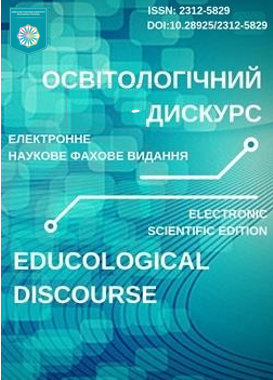Сучасні інформаційно-комунікаційні технології у підготовці прикордонників молодшої ланки в країнах Європейського Союзу
DOI:
https://doi.org/10.28925/2312-5829.2024.14Ключові слова:
інформаційно-комунікаційні технології, професійна підготовка, молодші інспектори прикордонної служби, мобільне навчання, компетентність, країни Європейського СоюзуАнотація
У статті схарактеризовано сучасні інформаційно-комунікаційні технології (далі – ІКТ), які застосовуються у процесі базової підготовки прикордонників країн Європейського Союзу, з метою адаптації передового закордонного досвіду в систему професійної підготовки молодших інспекторів прикордонної служби у відомчих закладах освіти українського прикордонного відомства. Виявлено, що застосування у процесі професійної підготовки прикордонників ІКТ дозволяє оптимізувати загальний професійний розвиток молодших інспекторів прикордонної служби, мотивує персонал прикордонного відомства до вивчення нового матеріалу у зручний спосіб та у позанавчальний час, забезпечує реалізацію принципів мобільного навчання, розширює спектр можливих вправ та професійно-орієнтованих завдань, що сприяє кращому залученню слухачів до вивчення навчального контенту. З’ясовано, що розробка та впровадження освітніх ІКТ в систему професійної підготовки молодших інспекторів прикордонної служби впливає на зміст, форми, методи та принципи професійної підготовки прикордонників, із особливою увагою на застосування підходів орієнтованих на самостійну роботу слухачів. Розглянуті сучасні ІКТ на базі веб-платформ правоохоронних відомств країн Європейського Союзу дозволяють молодшим інспекторам прикордонної служби займати активну позицію в процесі оволодіння новими знаннями, самостійно визначати порядок, темп, та спосіб отримання знань, і наразі є ключовим елементом професійної підготовки персоналу у відомчих закладах освіти українського прикордонного відомства.
Завантаження
Посилання
Kremen V., Bykov Yu. (2014). Innovatsiyni zavdannya suchasnoho etapu informatyzatsiyi osvity. [Suchasni informatsiyni tekhnolohiyi ta innovatsiyni metodyky u pidhotovtsi fakhivtsiv]. Modern information technologies and innovative methods in the training of specialists: methodology, theory, experience, problems. Ed. Kyiv-Vinnytsia, Ukraine: Planer LLC, p. 3-15.
Boitsun, O. B. (2009). Tekhnolohiya pidhotovky studentiv koledzhu tekhnichnoho profilyu do zastosuvannya informatsiynykh tekhnolohiy u profesiyniy diyalʹnosti [Technology of training college students of a technical profile for the use of information technologies in professional activity]: dissertation. ... candidate ped. Sciences: 13.00.04. Vinnytsia. 286 p.
Gurevich, R., & Dominskyi, O. (2000). Kompiuterni tekhnolohiyi navchannya yak zasib dystantsiynoyi vyshchoyi osvity. Shlyakhy reformuvannya zaochnoyi (dystantsiynoyi) vyshchoyi osvity [Computer learning technologies as a means of distance higher education. Ways of reforming correspondence (distance) higher education]. Vseukr. science and method conference, October 11–13, 2000, K.: Ukr. Acad. printing house, 53-55.
Bilous, O. V. (2014). Formuvannya informatsiyno-komunikatsiynykh kompetentnostey u konteksti yevrointehratsiynykh protsesiv stvorennya informatsiynoho osvitnʹoho prostoru [Formation of information and communication competences in the context of European integration processes of creating an informational educational space]. Manual. National Academy of Sciences of Ukraine, Institute of Inform. technology and means of education Kyiv: Atika. 212 p.
Turchyn, T. M. (2015). Pedahohika mystetstva [Pedagogy of art] teaching. manual Chernihiv national ped. University named after T.G. Shevchenko. Chernihiv: Desna Polygraph, 255-266.
Gura, A. (2018). Informatsiyno-komunikatsiyni tekhnolohiyi v pidhotovtsi maybutnikh uchyteliv pryrodnychykh spetsialʹnostey. [Information and communication technologies in the training of future teachers of natural sciences]. Young Scientist, 7 (59), 64-66.
Schengen Borders Code E-learning Tool. URL: https://www.oss.strazgraniczna.pl/oss/aktualnosci/19615,Schengen-Borders-Code-E-learning-Tool.html
FIELDS database. URL: https://www.interpol.int/How-we-work/Border-management/FIELDS-database
Common European Framework of Reference for Languages (CEFR). URL: https://www.coe.int/en/web/common-european-framework-reference-languages/level-descriptions
Biliavets, S. Y., Didenko, O. V., Kupriienko, D. A., Moskalenko, O. I., & Sychevskyi, Y. O. (2019). Application of information and communication technologies for improving professional preparation of future border guard officers. Information Technologies and Learning Tools, 70(2), 86–103. https://doi.org/10.33407/itlt.v70i2.2522
CEPOL's Online Blended Course “Trafficking in human beings for the purpose of sexual exploitation in the digital age”. URL: https://www.cepol.europa.eu/training-education/online-course-2010-2023-onl-trafficking-human-beings.
Bui, S. (2020). Top Educational Technology Trends In 2020-2021. URL: https://elearningindustry.com/top-educational-technology-trends-2020-2021
Опубліковано
Як цитувати
Номер
Розділ
Ліцензія
Авторське право (c) 2024 Освітологічний дискурс

Ця робота ліцензується відповідно до Creative Commons Attribution-NonCommercial 4.0 International License.
Автори зберігають за собою всі авторські права та одночасно надають журналу право першої публікації на умовах лізенції Creative Commons Attribution-NonCommercial-ShareAlike 3.0 Unported License, що дозволяє розповсюджувати даний матеріал із зазначенням авторства та первинної публікації в даному журналі.




















